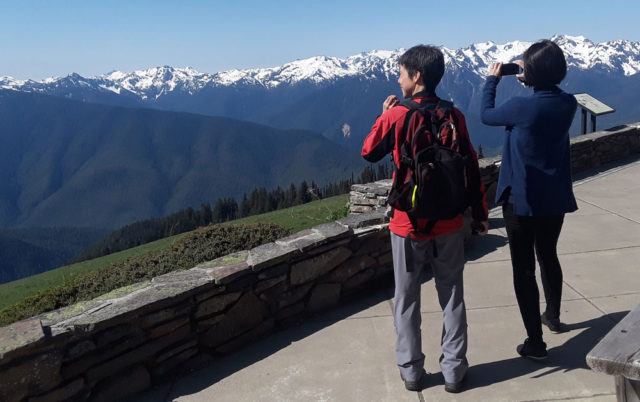By David Yamaguchi, The North American Post
IN MID-MAY, I noted the Japanese ad for bilingual driver/guides on the classified page of this paper. Curious, I followed it to the associated website. There, I found that Puget Sound Coach Lines is a regular charter bus company that also uses its vehicle fleet—which includes sedans and vans—to run guided trips for Japanese visitors around greater Puget Sound. The destinations include Mount Rainier and Olympic National Parks. Intrigued, I sent in an application letter and met with the owner, Kaz Yasuda, after which we decided to give each other a try.
My pitch was that Seattle-born Japanese Americans who can communicate with his clients have the potential to lead more interesting tours than Japanese expatriates. This is because [a] as natives, we know the land better and [b] we are Americans, whom most Japanese lack opportunities to converse with at length. Thus, in addition to sharing the sights, JA guides can offer a more immersive American experience.
After clearing some basic paperwork including insurance, I received my first email listing the tours that were booked for the following week. My training would involve riding along on trips led by experienced guides a few times a week for 2-3 weeks. A nature boy since my teenage years, I naturally checked the Olympics and Mount Rainier trips, as well as one in town as well.
The next morning, I met the tour leader, Kay Ishii, in a downtown hotel lobby. She fit my mental image of the Northwest mountain guide I had been watching for. She is a tomboy with a no-fuss pixie haircut. She was dressed head to toe in lightweight red and gray “Mammut” hiking gear. What especially caught my eye was that her outfit is not new; instead it has a well-worn look. She is no city chick.
Kay introduced herself simply as a “Nisei,” and we chatted a few minutes in English. Kay explained that Japanese travelers book the tours through Japanese travel companies, such as JTB and H.I.S.
As we spoke, the clients, a Japanese couple in their fifties, approached us in the lobby and introduced themselves. Kay flipped into native-level Japanese—which surprised me as her spoken English is no different from mine—and we were out the door and on our way to the Bremerton ferry in a Toyota Sienna.
“Sugu soba desu yo,” Kay explained to our guests. It is close by.
Over the morning, we learned that our guests were empty nesters who were in Seattle for a week. In turn, Kay explained that she attended first and second grades of elementary school in Japan, then completed high school in the US before returning to Japan for college. She lived in Japan for 12 years before returning to the US by way of Australia, where she also worked. As our guests were also world travelers, Kay described a wandering self-guided trip she and her husband took to Europe. The three spoke of Portugal, of Italy…
During the day, Kay struck me as something of a walking encyclopedia. She seemed to be conversant on whatever topic came up, including pro sports—especially baseball and soccer—and current news (in Japan and in the US). Linguistically, she reminded me of JAL employees, whom one meets now and then, where even after several hours, it is hard to tell whether they are Japanese or American.
What just killed me about Kay was that once we got into the forest, she also knew the English and Japanese names of the plants and trees. She would be tough to beat at this game. Later, Kay explained that she is a volunteer meadow-rover, in the alpine flower-fields above Paradise at Mount Rainier, when she isn’t guiding Japanese travelers.
At day’s end, I was sad to say goodbye to my three new friends. The driver/guide role fits free spirits like Kay, for on the road, there is no boss in sight. It is just the clients and her. Some she keeps in touch with to this day.
BEYOND my first day of training, two larger questions had been in my mind since seeing the ad.
[1] Why had I never heard of this company before, during my 13 years of writing for the NAP?
As owner Kaz explained, to date he has only advertised for driver-guides in strictly Japanese-readership media, such as YouMaga. His recent ads in the Post have been something new.
[2] Can Puget Sound Coach Lines fill the Nikkei day-trip niche being vacated by the ongoing closure of Keiro Northwest, including its Nikkei Horizons Continuing Education program? That is, healthy seniors still want to go places. They just don’t want to do the driving anymore.
[3] Can the coach lines fulfill an employment gap for Seattle Japan Exchange and Teaching [JET] program alumni returning from Japan? Many such individuals speak competent Japanese, yet lack sufficient reading and writing skills to fill office jobs for Seattle-based Japanese employers. Similarly, JET-level Japanese is also probably insufficient to work as local medical translators, where exact communication is essential. Thus, the tour-guide role may offer a better fit.
In any case, I just find it interesting that a small local Nikkei bus company is filling the Japanese tourism/eco-tourism niche on the US/Japan interface.
PS. On my second outing in town, also with Kay, it became clear why something is familiar about the large white and blue bus of Puget Sound Coach Lines. The bus bears a logo of standing killer whale. By chance, it had passed me the day before in Pioneer Square. It is the bus used for the Minidoka Pilgrimage.







